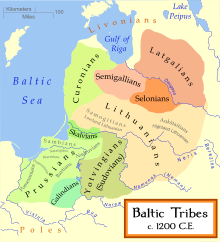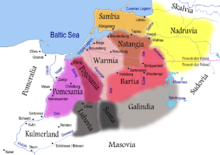Galindians: Difference between revisions
mNo edit summary |
mNo edit summary |
||
| Line 1: | Line 1: | ||
[[Image:Baltic Tribes c 1200.svg|thumb|right|The Western Galindians in the context of the other Baltic tribes, [[Wiktionary:circa|circa]] 1200 [[Common Era|CE]]. The Eastern Balts are shown in brown hues while the Western Balts are shown in green. The boundaries are approximate.]] |
[[Image:Baltic Tribes c 1200.svg|thumb|right|The Western Galindians in the context of the other Baltic tribes, [[Wiktionary:circa|circa]] 1200 [[Common Era|CE]]. The Eastern Balts are shown in brown hues while the Western Balts are shown in green. The boundaries are approximate.]] |
||
[[File:Slav-7-8-obrez.png|thumbnail|Europe in 7-8th century - Baltic tribes are shown in dark purple. Eastern Galindians can be seen within the Slavic territory.]] |
[[File:Slav-7-8-obrez.png|thumbnail|Europe in 7-8th century - Baltic tribes are shown in dark purple. Eastern Galindians can be seen within the Slavic territory.]] |
||
'''Galindians''' were two distinct, and now extinct, tribes of the [[Balts]]. Most commonly, Galindians refers to the Western Galindians who lived in the southeast part of [[Prussia (region)|Prussia]]. Less commonly, it is used for a tribe that lived in the area of what is today [[Moscow]]. |
'''Galindians''' were two distinct, and now extinct, tribes of the [[Balts]]. Most commonly, Galindians refers to the Western Galindians who lived in the southeast part of [[Prussia (region)|Prussia]]. Less commonly, it is used for a tribe that lived in the area of what is today [[Moscow]].[[File:Prussian clans 13th century.png|thumb|The Prussian tribes in the 13th century (Galindia shown in grey).|left]] |
||
The name "Galinda" is thought to derive from the Baltic word *''galas'' ("the end"), alluding to the fact that they settled for some time further west and further east than any other Baltic tribe. |
The name "Galinda" is thought to derive from the Baltic word *''galas'' ("the end"), alluding to the fact that they settled for some time further west and further east than any other Baltic tribe. |
||
== Western Galindians == |
== Western Galindians == |
||
The Western Galindians ([[Old Prussian]]: *''Galindis'',<ref group="nb">An asterisk placed before the word means that it is [[Linguistic reconstruction|reconstructed]] and is therefore not attested.</ref> [[Latin]]: ''Galindae'') – at first a West Baltic [[tribe]], and later an Old Prussian [[clan]] – lived in '''Galindia''', roughly the area of present-day [[Masuria]] but including territory further south in what would become the [[Duchy of Masovia]]. The region lay adjacent to the territory of the [[Yotvingians]], which is today in [[Podlaskie Voivodeship]]. |
The Western Galindians ([[Old Prussian]]: *''Galindis'',<ref group="nb">An asterisk placed before the word means that it is [[Linguistic reconstruction|reconstructed]] and is therefore not attested.</ref> [[Latin]]: ''Galindae'') – at first a West Baltic [[tribe]], and later an Old Prussian [[clan]] – lived in '''Galindia''', roughly the area of present-day [[Masuria]] but including territory further south in what would become the [[Duchy of Masovia]]. The region lay adjacent to the territory of the [[Yotvingians]], which is today in [[Podlaskie Voivodeship]]. |
||
Revision as of 22:50, 24 March 2022


Galindians were two distinct, and now extinct, tribes of the Balts. Most commonly, Galindians refers to the Western Galindians who lived in the southeast part of Prussia. Less commonly, it is used for a tribe that lived in the area of what is today Moscow.

The name "Galinda" is thought to derive from the Baltic word *galas ("the end"), alluding to the fact that they settled for some time further west and further east than any other Baltic tribe.
Western Galindians
The Western Galindians (Old Prussian: *Galindis,[nb 1] Latin: Galindae) – at first a West Baltic tribe, and later an Old Prussian clan – lived in Galindia, roughly the area of present-day Masuria but including territory further south in what would become the Duchy of Masovia. The region lay adjacent to the territory of the Yotvingians, which is today in Podlaskie Voivodeship.
The name Galind- is probably derived from the hydronym of Gielądzkie Jezioro (53° 52' N, 21° 10' E) in the province of Olsztyn, in what was the very center of ancient Galindia. J. Nalepa (1971) suggested the root *gal- was originally a different ablaut grade of the same root found in Lith. "gilus" – deep, and "gelmė" – depth. The original meaning referred to the depth of the lake mentioned, which is one of the deepest in the area.[1]
Ptolemy was the first to mention the Galindians (Koine Greek: Galindoi – Γαλίνδοι) in the 2nd century AD.[2] From the 6th/7th century until the 17th century the former central part of the Galindian tribe continued to exist as the Old Prussian clan of *Galindis. The language of the Old Prussians in Galindia became extinct by 17th century, mainly because of the 16th centuries influx of Protestants seeking refuge from Catholic Poland into the Galindian area[citation needed] and German-language administration of Prussia.
Eastern Galindians
The Eastern Galindians (East Galindian: *Galindai, Template:Lang-ru, from Old East Slavic *Golędĭ), an extinct East Baltic tribe, lived from the 4th century in the basin of the Protva River, near the modern Russian towns of Mozhaysk, Vereya, and Borovsk. It is probable that the Eastern Galindians, as the bearers of the Moshchiny culture, also occupied all the Kaluga Oblast before the Early East Slavs populated the Moshchiny culture's area at the turn of the 7th and 8th centuries.[3]
The Golyad are first mentioned in the Laurentian Codex, where it is written that they were conquered by Iziaslav I of Kiev in 1058.[4] This shows that even at the height of the power of the Kievan Rus', were not its subjects or tributaries.[5] The Hypatian Codex mentions that Sviatoslav Olgovich defeated the Golyad' who lived near the Porotva (now Protva) river in 1147.[4] The annals mentioned that Mikhail Khorobrit killed by "Lithuania on the Porotva" (Template:Lang-ru) in 1248, which clearly refers to the Galindians.[6]
The Prince Yuri Dolgorukiy arranged a campaign against them in 1147, the year of the first mention of Moscow in the Russian chronicles.[citation needed] Subsequent chronicles do not mention the Eastern Galindians.[citation needed]
Nevertheless, the Russians probably did not completely assimilate them until the 15th (or 16th) century.[6][7] Some people still identified as Goliads in the 19th century.[8] Their folk traditions lived on into the 20th century.[4]
In modern Moscow there is Golyadski lane.
See also
Notes
- ^ An asterisk placed before the word means that it is reconstructed and is therefore not attested.
References
- ^ Nalepa, Jerzy, 'Próba nowej etymologii nazwy Galindia czyli Golędź.', Opuscula. Slavica 1, [=Slaviska och baltiska studier 9]: 93-115. Lund 1971 Även publicerad i: Acta-Baltico Slavica 9: 191-209. Wrocław 1976.
- ^ Tarasov 2017, p. 99.
- ^ Sedov 1982, p. 41-45.
- ^ a b c Bojtár 1999, p. 109.
- ^ Studia Ucrainica (3): 24. 1986 https://www.google.com/books/edition/Studia_Ucrainica/dsgcAAAAMAAJ?hl=en&gbpv=1.
{{cite journal}}: Missing or empty|title=(help) - ^ a b Sedov 2000, p. 75-84.
- ^ Tarasov 2017, pp. 100–112.
- ^ Wixman 2017, p. 75; The Golyad are the descendants of a Baltic tribe (Galinds) who were assimilated by the Belorussians (in Brest and Grodno Guberniyas) and Ukrainians (in Volynia). They lived along the Ugra and Protva rivers. There were still individuals who referred to themselves as Golyad in the 19th cent.
Sources
- Bojtár, Endre (1999). Foreword to the Past: A Cultural History of the Baltic People. Central European University Press. ISBN 9789639116429.
- Tarasov, Ilya (2017). "Балты в миграциях Великого переселения народов" [Balts in the migrations of the Great Migration]. Исторический формат (in Russian). 3–4 (11–12): 95–124.
- Wixman, Ronald (2017). Peoples of the USSR: An Ethnographic Handbook. London and New York: Routledge. ISBN 9780873325066.
- Sedov, V.V. (1982). Восточные славяне в VI-XIII вв [Eastern Slavs in the VI-XIII centuries] (in Russian).
- Sedov, Valentin V. (2000). "Голядь" [Golyad']. In Kazakevičius, Viktoras (ed.). Iš baltų kultūros istorijos. Vilnius: Diemedis. pp. 75–84. Archived from the original on 2011-07-18.
